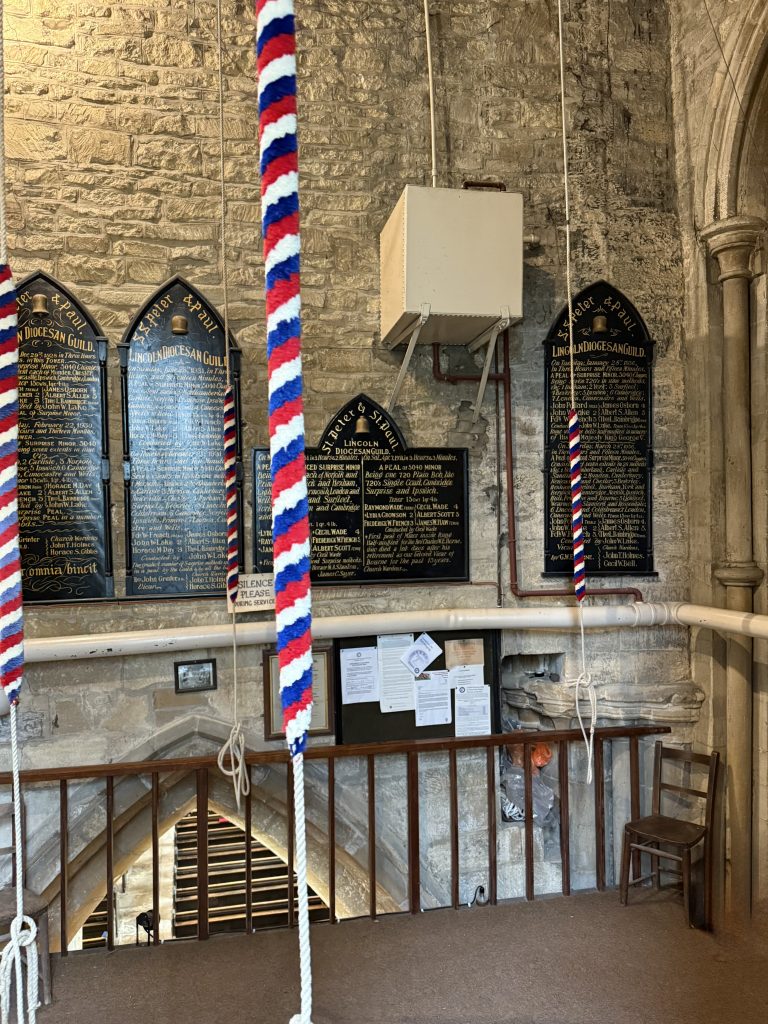
The bells at Bourne Abbey
The abbey has a ring of six bells hung for full circle ringing from a gallery.
The tenor (largest bell) weighs 15cwt 1qrt 4lb (778kg) in G. The oldest bells (No’s 1 & 5) were cast in 1729 by Henry Penn of Peterborough but No’s 2, 4, & 6 were recast in 1926 by Gillet and Johnson and No.3 was recast by Mears and Stainbank in 1905, both London Founders.
The bells are hung in a cast iron low sided frame mounted on wooden base beams that was installed in 1905.
A small Sanctus bell, which sits outside the main frame, was cast by Thomas Norris of Leicester and is swung for chiming only.
Ringing
The bells are rung from 10.30 am to 11.00 am for the Sunday service and for other special services and occasions.
Ringing practice is joint with other ringers at Irnham on Tuesday 2.30 pm to 4.00 pm. (check with contact for confirmation).
Visiting ringers are welcome.
Contacts
Tower Captain and Tower Correspondent:
Alan G Payne, Old Hall Farmhouse, Wilsthorpe, Stamford, Lincs, PE9 4PE
Tel. 01778 560633 Email. alanpayne684@gmail.com
What is Bell Ringing all about?
Bell ringing is a team activity that stimulates the brain and helps keep you fit… it also makes a glorious sound! Many consider ringing to be their contribution to church life, others do it for the pure pleasure it brings.
Ringers come from all walks of life and range in age from ten to those in their eighties.
Ringing is well within the capabilities of most people. The initial teaching takes several weeks, after which a learner can begin to ring with the rest of the band. Most ringers practise once or twice a week and ring for a church service.
Many ringers enjoy the social side including ringing at the many different towers in the UK and abroad where they are universally welcomed. Some enjoy performance ringing which includes “peals” of a specific method (music) or length (number of changes). There is endless variety available in this area and opportunity to learn new things.
What is Change Ringing?
The origins of change ringing lie in the sixteenth century when church bells began to be hung with a full wheel. This gave ringers control of their bell, which allowed sets of bells (rings) to be rung in a continuously changing pattern.
Music is created by moving up and down the ringing order to a defined sequence of changes known as a method. Learning a few simple methods allows ringers to join in with other bands in towers around the world. There are rings of 5, 6, 8, 10, and 12 bells and with the method variations available on these rings they make the learning and joy of change ringing one of endless opportunity but one at which individuals can proceed at their own pace.
There are other formats and activities that can be explored including change ringing on handbells and composition.
Should you wish to learn to ring or require more information please contact the Tower Captain and Tower Correspondent (details above) or use one of these links:
Lincoln Diocesan Guild of Church Bell Ringers www.ldgcb.org.uk
The Central Council of Church Bell Ringers www.cccbr.org.uk